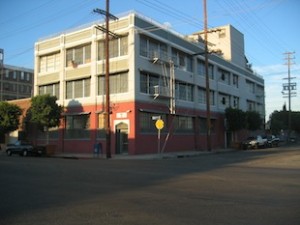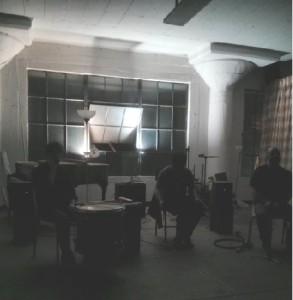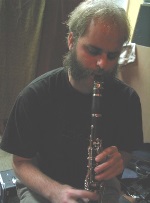Tim Feeney, Matt Ingalls and Ken Ueno in Los Angeles at the Wulf
 On Friday night, November 1st the Wulf in downtown Los Angeles presented a program by three outstanding improvisational musicians: Tim Feeney on percussion, Ken Ueno, vocals and Matt Ingalls, clarinet. A little over an hour of improvisational music was offered in the reclaimed second-story industrial loft that is the Wulf, and a small but dedicated group of listeners gathered comfortably in the informal space. On this occasion there were no overhead lights – just a single back light behind the performers – and this added to the unusual atmosphere.
On Friday night, November 1st the Wulf in downtown Los Angeles presented a program by three outstanding improvisational musicians: Tim Feeney on percussion, Ken Ueno, vocals and Matt Ingalls, clarinet. A little over an hour of improvisational music was offered in the reclaimed second-story industrial loft that is the Wulf, and a small but dedicated group of listeners gathered comfortably in the informal space. On this occasion there were no overhead lights – just a single back light behind the performers – and this added to the unusual atmosphere.
The three performers all have long experience playing experimental music using extended techniques. Tim Feeney came equipped with a table full of items for percussion: files, steel bars, a variety of mallets, a wooden stick, scrapers, copper plates and several bows. Tim has played extensively in Boston’s improvising community and has appeared at experimental spaces such as the Red Room in Baltimore, Boston’s Institute of Contemporary Art and Firehouse 12 in New Haven, Connecticut.
Ken Ueno is a composer and vocalist who is accomplished in Heavy Metal sub-tone singing , Tuvan throat singing and other extended vocal techniques. He includes attending West Point and winning a Rome Prize in his extensive resume and has appeared at Lincoln Center, the Kennedy Center, the Metropolitan Museum of Art and Musik Triennale Köln Festival among many others.
According to his website, Matt Ingalls is “ a prominent figure in the San Francisco Bay Area Improv Scene, and is known for his ‘composerly’ solo improvisations that explore extended techniques on his instrument that interact with the acoustic space, often as combination tones.” Matt is also founder and co-director of sfSound a new music ensemble, and is active in computer music programming.
 The first piece began with a series of quiet gestures : a breath of air through the clarinet, the soft rubbing of the drum head and a low vocal whooshing sound that combined to evoke a dark, windswept plain at night. A lonely sort of howl sounded in the distance, adding to the wilderness atmosphere. As the early part of the piece progressed the sounds grew louder and more distinct – a heavier scraping on the drum, a distinct huffing sound from the vocals and regular squeaks from the clarinet. A solo voice drone with vocalise accompanied by bowing on the drum produced an interesting sonic combination. Other combinations of voice, clarinet and percussion took their turn – with one player resting – as the piece continued, building in intensity. As the clarinet reached a full screeching cry the effect was palpably primal in its impact.
The first piece began with a series of quiet gestures : a breath of air through the clarinet, the soft rubbing of the drum head and a low vocal whooshing sound that combined to evoke a dark, windswept plain at night. A lonely sort of howl sounded in the distance, adding to the wilderness atmosphere. As the early part of the piece progressed the sounds grew louder and more distinct – a heavier scraping on the drum, a distinct huffing sound from the vocals and regular squeaks from the clarinet. A solo voice drone with vocalise accompanied by bowing on the drum produced an interesting sonic combination. Other combinations of voice, clarinet and percussion took their turn – with one player resting – as the piece continued, building in intensity. As the clarinet reached a full screeching cry the effect was palpably primal in its impact.
At this point, as the intensity subsided somewhat, Matt Ingalls switched over to an apparatus consisting of a garden hose fitted with a bass clarinet reed and what seemed to be an extendable tube that might have been a vacuum cleaner attachment. This produced a low reedy sound whose pitch and volume was modified by the position of the extendable tube and by a plate held to its end, used in the manner of a horn player stopping the bell. This produced a low, mournful sound that combined nicely with the bowed drum and the overall effect as the piece concluded was that we were in the presence of something alien, but nevertheless sympathetic.
 The second piece opened with a series of long, low clarinet tones. In time this was joined by a light tapping of the drum and soft vocals. The clarinet broke into a series of scales and arpeggios that gave the texture a bright, active feel that increased in dynamic as the piece progressed. Eventually the clarinet – amplified – produced an almost painful series of shrieks and screeches accompanied by a rapid tapping in the percussion and a forceful drone in the voice. A series of trills by the clarinet quickly broke into powerful sheets of sound that poured out – reminiscent of Coltrane or a Rahsaan Roland Kirk – in a fluid and intense expression. The familiar sonic territory exerted a strong pull on this listener – you could feel the old dynamism welling up and it was the perfect compliment to what had gone before. The piece slowly wound down from this high point and the voice, percussion and clarinet recombined effectively to produce a calming sense of the sacred as the piece concluded.
The second piece opened with a series of long, low clarinet tones. In time this was joined by a light tapping of the drum and soft vocals. The clarinet broke into a series of scales and arpeggios that gave the texture a bright, active feel that increased in dynamic as the piece progressed. Eventually the clarinet – amplified – produced an almost painful series of shrieks and screeches accompanied by a rapid tapping in the percussion and a forceful drone in the voice. A series of trills by the clarinet quickly broke into powerful sheets of sound that poured out – reminiscent of Coltrane or a Rahsaan Roland Kirk – in a fluid and intense expression. The familiar sonic territory exerted a strong pull on this listener – you could feel the old dynamism welling up and it was the perfect compliment to what had gone before. The piece slowly wound down from this high point and the voice, percussion and clarinet recombined effectively to produce a calming sense of the sacred as the piece concluded.
This performance was an impressive display of what can be created with extended techniques in the hands of experienced and capable improvising musicians. The varied sounds that were produced by all three players during the course of this performance was a real marvel and gives us a fine example of what is possible beyond the limits of conventional playing.
The next offering at the Wulf will be on November 17, 2013 with James Klopfleisch presenting.